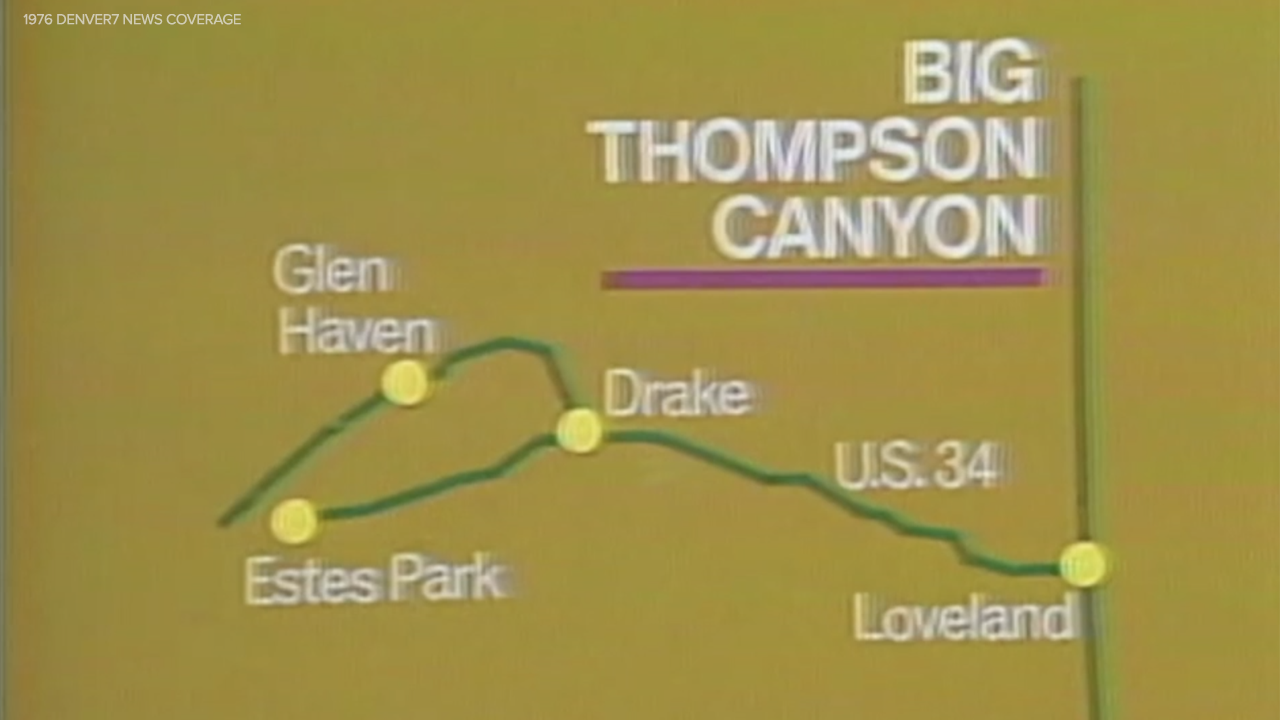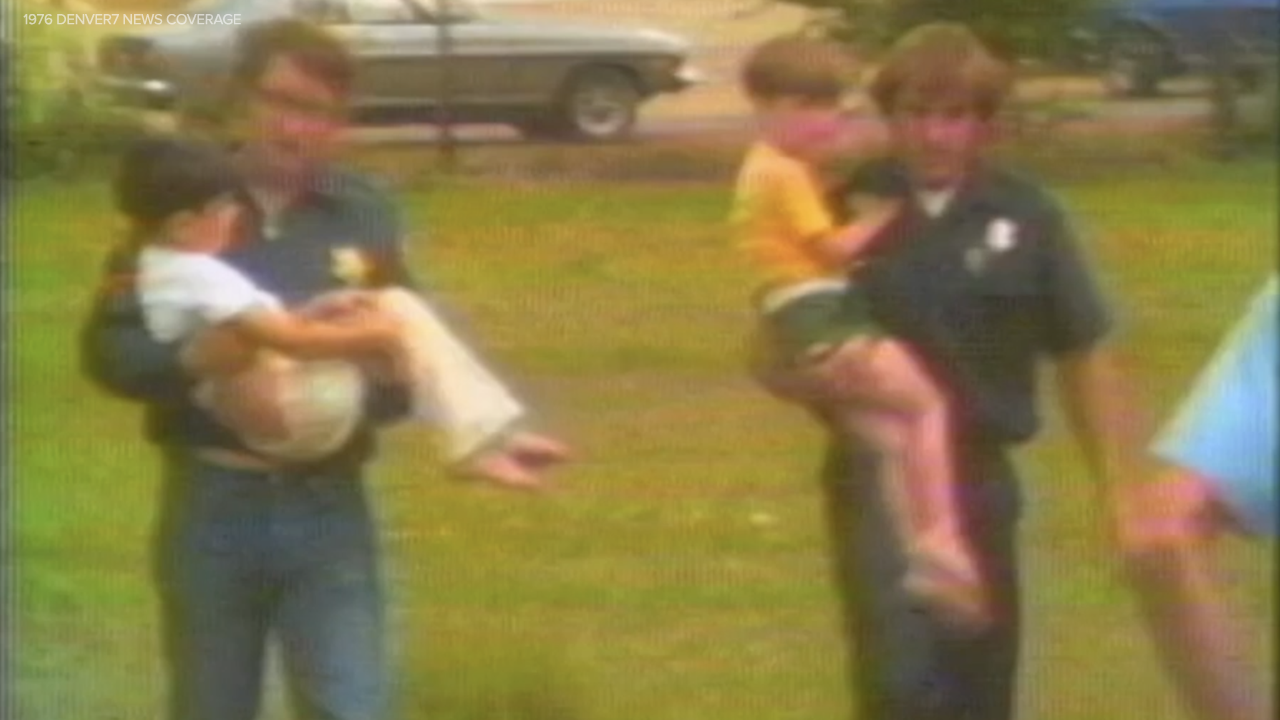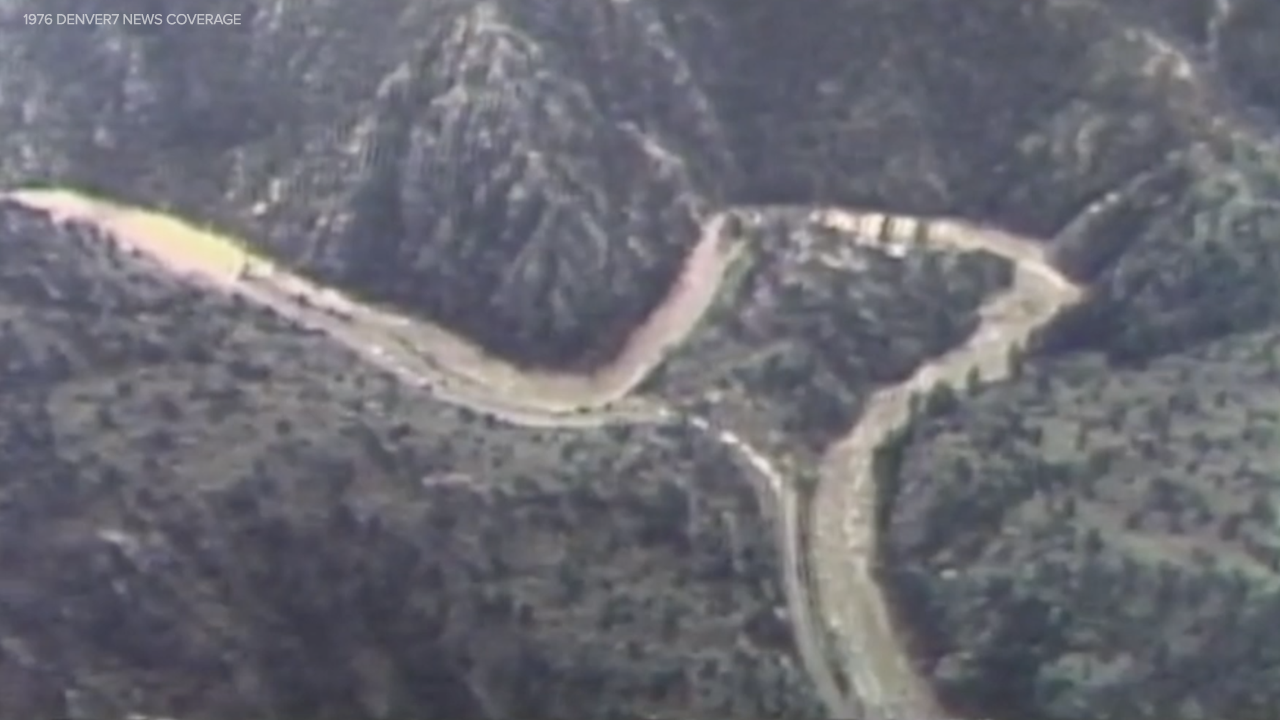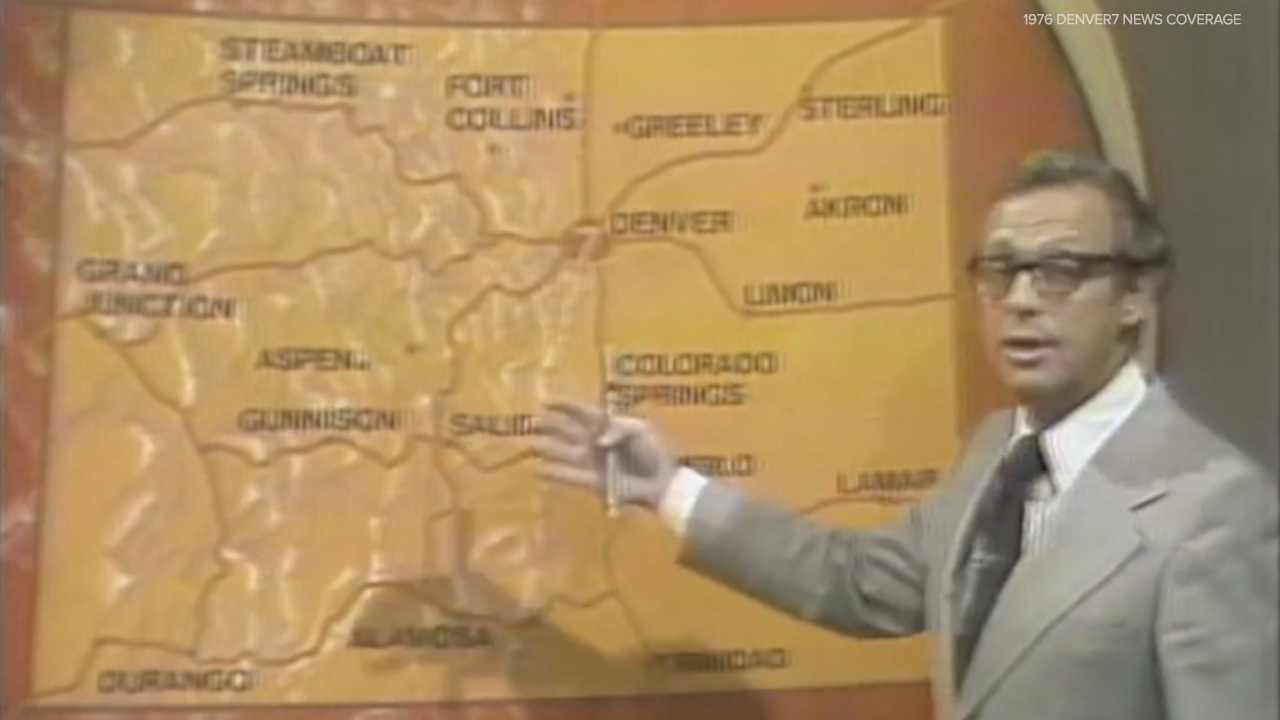LARIMER COUNTY, Colo. — It was one of the worst natural disasters to ever strike Colorado when a 20-foot “wall” of water rushed through Big Thompson Canyon west of Loveland in Larimer County.
There was little warning of what was about to happen on the evening of July 31, 1976. Most people who did receive an alert only had a few minutes to react as a catastrophic wall of water rushed down the Big Thompson River claiming the lives of 144 people quickly becoming one of the deadliest flash floods in Colorado’s history.
As Denver7 marks its 70th anniversary on November 1, we are looking back at news coverage of some of the most impactful stories ever reported in Colorado
That horrific July evening, it’s estimated up to 3,500 people were inside their homes, vehicles or enjoying the outdoors in Big Thompson Canyon in Larimer County when the skies opened up that evening, dropping unprecedented amount of water down the canyon's slopes and floor. Of the 144 people who lost their lives during the flood, officials estimated the bodes of five people were never found.
47 years later, the impact and final damage are known, but we want to take you back and show you how the story unfolded so you can see how Coloradans reacted to the tragedy.
This story details the timeline from a nineteen-minute Denver7 newscast that aired the following day on the afternoon of August 1, 1976.

“The daylight revealed hundreds of cabins, barns, cars, trucks, campers and trailers in the river,” Denver7 (known then as KMGH 'The News') anchor Bob Palmer began the broadcast. “Of those caught by the flood many escaped by climbing the steep canyon walls. Others who tried to make it down the road were swept to their deaths.”
Daylight began to reveal the true scope of the disaster.
Early footage from Denver7’s helicopter showed high water remained in canyon hours as rescue and military helicopters surveyed the scene for survivors.
“Highway 34, which skirted the river, was washed out for miles. At least 800 persons have been brought out during the day by land and air, many of them injured, all telling them the most horrible night of their lives,” said anchor Palmer. “A temporary morgue has been established in Loveland as helicopters and horseback teams are still ferrying bodies out of the mountains.”
It was as if portions of Highway 34 never existed, completely wiped away.
It was reported an estimated 300 people were still trapped in their vehicles hours after the flooding began along a four-mile stretch of the highway that somehow remained intact during the floods.
Permanent residents along the canyon did receive some warning of the impending flood, but the majority of victims were those people who were camped alongside the river and only received the first hint of trouble when the water rapidly rose along darkened campgrounds.

The disaster began when a storm system stalled along a portion of the canyon at around 6:30 p.m. on July 31, 1976, the National Weather Service reported. The incredible amount of rain kept coming and didn't let up until just before midnight. The same storm system created havoc int the Denver area, knocking our radar at Stapleton Airport. But the metro impacts were nothing compared to what was unfolding in Larimer County.
There were reports of high water late on the evening of July 31, but no indication of any impending tragedy. “Last night when producer Ernie Thornton finished work on his 10 o'clock news, he and photographer Gary Avalon went to check and they spent all night in the canyon,” KMGH anchor Palmer reported. “Some survivors reported a 15 -foot wall of water that hit at about 10 p.m. and telephone service to Estes Park has been knocked out. The town's sewer pipes ruptured sending raw sewage down the river along with everything else.”
Just after midnight, rescuers were able to locate hundreds of stranded campers and residents of the canyon who had no place to go after the floods but turbulence complicated rescue helicopter efforts.
“The hundreds who were trapped along the Big Thompson used headlights and flashlights to signal to the helicopter above, but the rescue operations would have to wait until morning. Gusty winds, darkness and the torrential downpour left the chopper helpless,” Denver7 photojournalist Ernie Thornton reported from the scene. “10 helicopters were ferrying people out of the disseminated narrow canyon. It was a constant stream of injured and exhausted people who arrived in a pasture that served as a temporary help support.”
The Cedar Cove area, two miles west of Loveland, was virtually torn apart, and residents who made it out said they only had five to 10 minutes warning before being hit by a tidal wave of water reaching 10 feet high.

“Some of the evacuees clutched waterlogged dogs as they left the rescue helicopters. Others who could not walk were carried away on stretchers,” reported Thornton. “Some were given first aid and emergency treatment on the scene, while others were immediately taken to hospitals in Loveland and Fort Collins. The lucky ones who were not injured were taken to Loveland High School.”
Once at safety, the surviving flood victims could only eat, sleep and wait in stunned silence. Many people had to bear the agony of not knowing about the fate of loved ones.
Cliff Dykeman was with his wife and three daughters below Estes Park when the storm struck and recounted his expeience to Denver7 photojournalist Thornton
“We went fishing then the rain came,” he started. Dykeman said his wife and three daughters packed up everything after a pause in the deluge, the rains returned and he was separated from his loved ones. “And they're up there somewhere in the valley. We hope still on the road,” said Dykeman.
“No word yet?” asked Thornton? “No word at all.” Dykeman replied.
Colorado Governor Richard Lamm joined Denver7 in our studio after he was out on the scene all night and was asked to describe what he saw in his own words.

“I think we were probably one of the first helicopters over it. And I think the most frustrating thing is how many people were so obviously in need of help and waving to us. There was no way we could get the big helicopter we were in down there,” said Governor Lamm during the news broadcast. “The cars were just a mishmash. There just have been, we could see 60 or 70 different cars, many of them with the headlights still on, and you just don't know whether the people are in them. That’s the terrifying thing, you just had no idea.”
The governor declared a major disaster area and ordered a massive response from the Colorado National Guard including numerous rescue helicopters but washed away roads complicated rescue efforts overnight.
“The individual acts of courage up there I'm sure that played out last night are going to be continued stories for the next month. There are some great people that came out of any disaster situation,” Governor Lamm said on Denver7 News.
Anchor Bob Palmer ended the segment: “Governor, let me volunteer the services of Channel 7. If there's anything we can do in the way of communications or reaching the public, just let us know.”
Survivors of the Big Thompson Canyon Flood shared their emotional stories with Denver7 that next day, including Gary Watson, whose family was vacationing in the canyon around 8 miles from Estes when the waters rushed through.
His wife and daughter survived but the couple’s baby was missing. Watson told Denver7 his family was in a cabin watching the rain when the water rushed under the door and kept getting higher until the entire cabin washed away.

“We were inside and when it went the whole cabin just completely - just like a tinker toy - just disintegrated. We were down under the water and next thing I knew I was in the water but I was able to walk out,” Watson recalled.
A Denver7 reporter asked: “And how about your children?” Watson emotionally added: “They’re fine, except for Aaron,”
“Did you lose him in the water?” the reporter asked? Watson was barely able to answer: “Yes.”
Denver7 reporter Jim Redmond was able to dial into the newscast from outside Loveland beaming a signal back to the station from a KMGH InstaCam Truck showing the aftermath and stunned survivors.
In Loveland, the flood cleanup was underway and rescue effort continued amid even more storm squalls.
“One of the most difficult problems that officials have here, outside of the weather problem, is figuring out just how many people were up in that canyon at the time that flood roared down on them,” Denver7’s Redmond Reported. “So far, they've rescued somewhere near 800 people, most of the 800 with one injury or another to their bodies, a lot of arms hurt, a lot of cuts and bruises that sort of thing.”

In an unprecedented and desperate effort to determine the full scope of the disaster, leaflets were dropped into the Big Thompson Canyon via helicopter asking survivors to mark on the ground different symbols to help rescuers decide what help was needed, “to mark out an ‘A’ on the ground if medical attention is needed, an “F” if they need food and a “W” for water,” Redmond said in the news report.
Along with Governor Lamm, Senator Gary Hart and Congressman Jim Johnson surveyed the damage and were working on disaster relief funds, Denver7 reported.
During the hours-long deluge, upwards of 12 inches of rain fell in some areas causing the Big Thompson River to rage at an estimated 31,200 cubic feet per second at the mouth of the canyon, according to a National Oceanic and Atmospheric report released after the disaster.
While a severe thunderstorm warning was issued by the Weather Service Forecast Office (WSFO) in Denver, limited on the ground reports from spotters and official rain gauge sources caused a delay in issuing a flood warning. It wasn't until 11 p.m. that the WSFO in Denver issued a flash flood warning, but by the the "Big Thompson had already crested at the mouth of the Canyon," the NOAA aftermath report revealed.
Illustrating the incredible force of the flood waters, the Larimer County Sheriff told Denver7 the 10 inches of rain in Estes Park roared down the canyon and completely knocked the Loveland Municipal Power Station, a brick building, right off its foundation.
“It's incredible, you wouldn't believe it if you saw it,” KMGH’s Redmond signed off his report.





